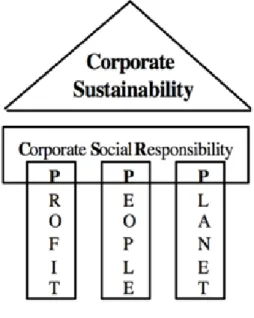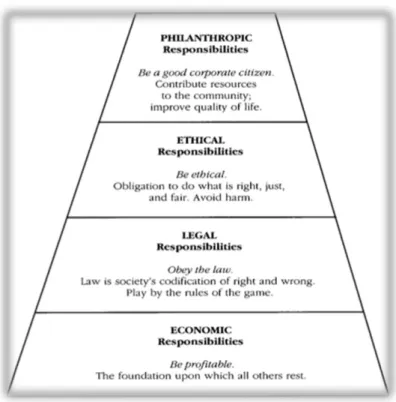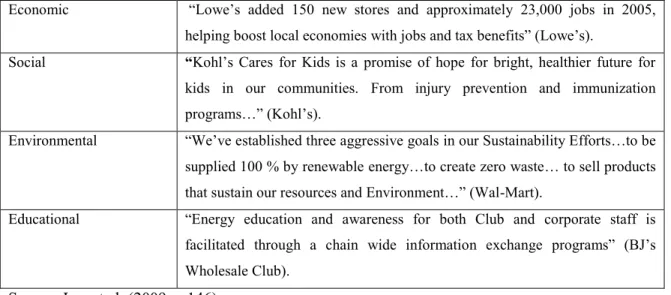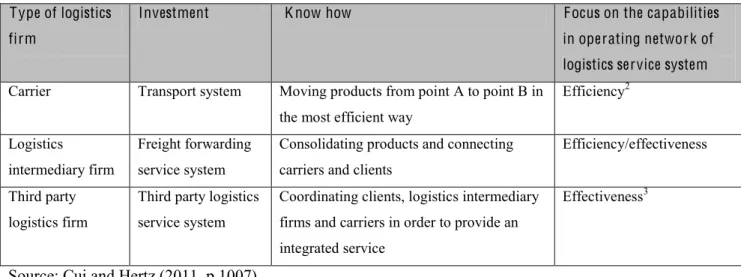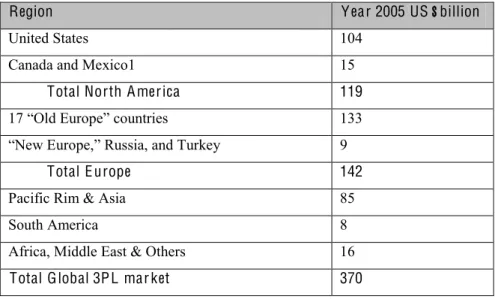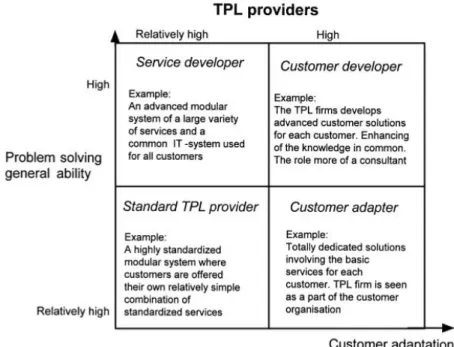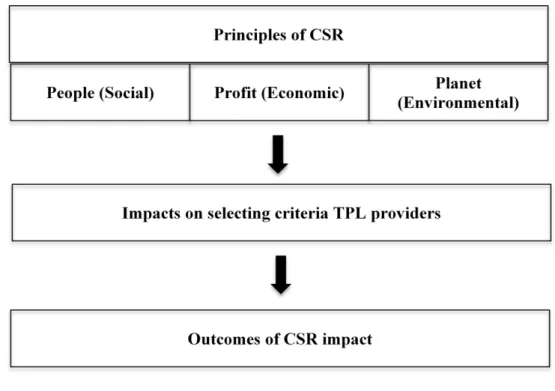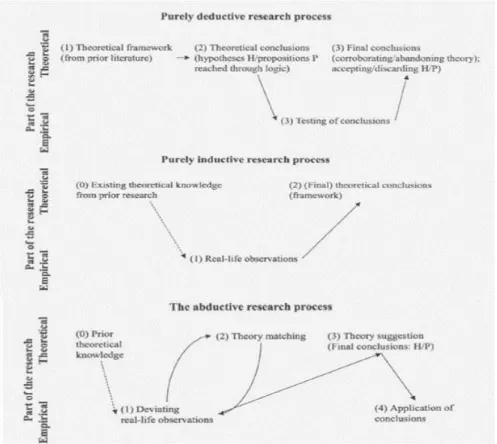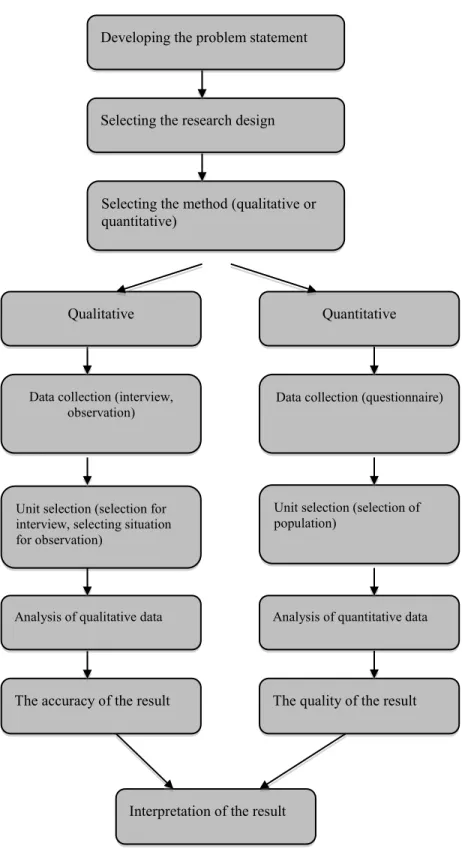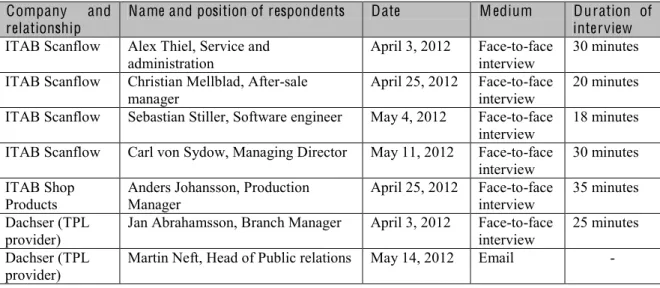Corporate Social Responsibility (CSR) impacts as selection criteria
when buying services from Third Party Logistics (TPL) providers:
A case study of ITAB Scanflow
Master thesis in Business Administration
Authors:
Pakitta
Kiatkulthorn
Thanaporn
Sathapornwanit
Tutor:
Professor Susanne Hertz
Jönköping, May 2012
Acknowledgements
First and foremost, we would like to thank our tutor Professor Susanne Hertz, for her guidance as well as her helpful feedback and support throughout the process of writing this thesis. Moreover, we would like to thank all of the respondents for their time and input during the interviews. Without their participation, the thesis would not have been concluded. Our regards to:
Alex Thiel: Service and administration, ITAB Scanflow
Carl von Sydow: Managing Director, ITAB Scanflow
Christian Mellblad: After-sale manager, ITAB Scanflow
Sebastian Stiller: Software engineer, ITAB Scanflow
Anders Johansson: Production Manager, ITAB Shop Products
Jan Abrahamsson: Branch Manager, Dachser
Last but not least, we are thankful for our beloved families, for always being beside us, and for the support given all the way from Thailand. Finally, we would give a special thanks to our friends and opponents during the seminar of the thesis.
Pakitta
K iatkulthorn
Thanaporn Sathapornwanit
Jönköping International Business SchoolMaster Thesis in Business Administration
Title: Corporate Social Responsibility (CSR) impacts as selection criteria when buying services from Third Party Logistics (TPL) providers
Author: Pakitta Kiatkulthorn, Thanaporn Sathapornwanit Tutor: Professor Susanne Hertz
Date: May, 2012
Abstract
Introduction – People and society are more concerned about Corporate Social Responsibility as well as the demand of outsourcing logistics services. When buyer companies select TPL providers, the selection criteria are focused on cost and on time delivery, while issues like CSR are often placed in a low priority.
Purpose – The purpose of this master thesis is to analyze how Corporate Social Responsibility (CSR) impacts as selection criteria when buying services from Third Party Logistics (TPL) providers.
Design/Methodology – The research approach of this thesis is qualitative. Both primary data and secondary data collection were used; semi-structured interviews, emails, field observation and documentation. There are seven respondents from three different companies.
Findings – From buyer companies’ perspective, CSR was taken into account when buying services from TPL providers. However, it had impact on a low priority since the buyer company chose leading TPL providers that have a good reputation and image. The buyer company believes that those selected TPL providers have already implemented CSR practice. Moreover, the results show that the main driving force behind the application of CSR was the customer requirement Research limitations – This master thesis has studied in a specific Swedish company when selecting TPL providers. Moreover, this research has been studied from the buyer companies’ perspective.
K eywords – Third Party Logistics (TPL) providers, Corporate Social Responsibility (CSR), Selection criteria of TPL providers, Logistics service provider.
Table of Contents
1.Introduction ... 1
1.1.Background ... 11.2.Problem statement ... 2
1.3.Purpose ... 3
1.4.Research questions ... 3
1.5.Delimitation ... 4
1.6.Thesis outline ... 4
2.F rame of Reference ... 6
2.1.CSR and its definition ... 6
2.1.1.The CSR framework ... 6
2.2.Logistics service providers (LSPs) ... 11
2.2.1.Activities of logistics service providers (LSPs)... 12
2.3.What is a TP L provider? ... 13
2.3.1.The Classification of TPLs providers ... 14
2.4.C riteria when selecting TP L providers ... 15
2.5.CSR in logistics providers ... 20
2.6.Driving forces for adopting CSR ... 21
2.7. Research F ramework of this study ... 23
2.8.Summary of F rame of Reference ... 24
3. Methodology ... 25
3.1.Research approach ... 253.2.Research design ... 26
3.3.Q uantitative method ... 28
3.4.Q ualitative method ... 28
3.5.Data collection ... 29
3.5.1.Primary data collection ... 29
3.5.2.Secondary data collection ... 31
3.6.Selecting samples ... 32
3.6.1.ITAB Scanflow and ITAB Shop Products ... 33
3.6.2.Dachser ... 34
3.6.3.Non-cooperation ... 34
3.7.Analysis of the empirical data ... 35
3.7.1.Data Analysis ... 35
3.7.2.Pressing for the high quality analysis ... 36
3.8.T rustworthiness of the research ... 37
3.9.Ethical concerns ... 37
3.10.Summary of Methodology chapter ... 38
4.Empirical research ... 39
4.1.Company Background ... 39
4.1.1.ITAB Scanflow ... 39
4.1.2.ITAB Shop Products ... 39
4.1.3.Dachser ... 40
4.1.4.Background information and companies’ relationship... 40
4.2.Driving forces of CSR ... 41
4.3.Selection criteria when buying services from TP L providers ... 42
4.4.1.Economic ... 44
4.4.2.Social responsibility ... 45
4.4.3.Ecology ... 45
4.5.Summary of empirical materials ... 46
5.Analysis ... 47
5.1.Driving forces of CSR ... 47
5.2.Selection criteria when buying services from TP L ... 48
5.3.CSR Practice in TP L providers ... 51
5.3.1.Economic ... 52
5.3.2.Social responsibility ... 52
5.3.3.Ecology ... 53
5.4.Summary of Analysis ... 53
6.Conclusion ... 55
6.1.Summary ... 556.2.Limitation of Study ... 55
6.3.Future research ... 56
7.References ... 57
8.Appendixes ... 64
8.1.Appendix 1: The interview guide ... 64
List of figures
Figure 2.1 CS, CSR, and 3Ps ... 7
Figure 2.2 The pyramid of CSR ... 9
Figure 2.3 The classification of TPL providers ... 14
Figure 2.4 The summary of selection criteria ... 17
Figure 2.5 Research framework ... 23
Figure 3.1: Purely deductive, inductive, and abductive research processes ... 25
Figure 3.2 The research design ... 27
Figure 3.3 The component of data analysis. ... 35
Figure 4.1 The relationship among actors. ... 40
Figure 5.1 CSR influence between relationships... 48
Figure 5.2 Dachser’s three facets of sustainability.. ... 51
List of tables Table 2.1 Examples of CSR statements as presented on website ... 9
Table 2.2 Examples of CSR statements as presented on website based on Triple bottom line ... 10
Table 2.3 Capabilities of LSPs in operating network of systems ... 12
Table 2.4 Capabilities of LSPs in managing network of physical flows ... 12
Table 2.5 Functions and activities associated with LSPs ... 12
Table 2.6 Global TPL market ... 13
Table 3.1 Summary of the primary data ... 32
1.Introduction
This chapter starts with discussion of the background and the problem statement of the thesis in order to present the reasons of why this issue deserves to be studied, followed by the purpose, research questions, delimitation sections and outline of the thesis.
1.1.Background
The logistics services - transport and warehousing including storage of goods, handling, reloading, handling and tracking services - represent an important part of the economy (Persson & Virum, 2001). Research by Transport Intelligence ranked the world's largest forwarders in 2010. The results showed that the European forwarders dominate the world market as the world ranking of freight forwarder companies, in terms of sea and air freight (Arabian supply chain, 2011). For instance, a German company -Deutsche Post- was ranked as 93 in 2011 according to the world’s biggest company and A.P. Møller-Maersk Group was ranked in 144 (CNN money, 2011). As Logistics industry grows more powerful, the need to establish rules around them becomes more important. For instance, the General Conditions of the Nordic Association of Freight Forwarders (NSAB) contain conditions relating to the forwarder's assignment in Nordic countries, for instance the right and obligation of freight forwarders and the customers, including the freight forwarder’s responsibility under transport law convention. NSAB is a matter of general interest for the cooperation, which applies to Nordic countries including Sweden, Norway, Finland and Denmark (Swed freight, 2011).
Even though people pay attention to the topic such as Corporate Social Responsibility at this moment (Andersen & Skjoett-Larsen, 2009), Porter and Kramer (2006) indicated that companies implement CSR due to pressure from stakeholders. They sometimes cannot see that CSR provides advantage for the firms. In addition, a number of research studies (Williamson, Lynch-Wood & Ramsay, 2006; Galbreath, 2010), found that many companies pursue CSR because of external pressure such as governments, but finally the results do not lead to long-term benefits. Moreover, the relationship between CSR and financial performance is unclear even though there are research studies conducted in this area (Chen & Wang, 2011).
Many researchers have treated the topic of TPL providers (Laarhoven, Berlund, & Peters, 2000; Persson & Virum, 2001), nevertheless with little evidence of analyzing the combination of
CSR and TPL providers, particularly the social dimension (Wolf & Seuring, 2010). The reason behind this could be that businesses in general are constantly searching for a competitive edge. Within the high competitive in market, companies look for the operational efficiency, by focusing on cost saving and shorter lead-time. The issues of CSR such as environmental concerns are frequently put away (Aronsson & Brodin, 2006) while most companies engage in CSR as a requirement from stakeholders.
1.2.Problem statement
Recently, not only the area of third party logistics (TPL) providers has been a surge of scholarly interest and publications (Selviaridis & Spring, 2007) but also the concept of corporate social responsibility (CSR) has become ordinary in many mission commitments, as it can be seen from the annual reports from businesses (Halldorsson, Kotzab & Skjøtt-Larsen, 2009).
CSR is becoming a dominant concern as more businesses seek to incorporate social and environmental issues into the daily basis operations of their companies (Lee, Fairhurst & Wesley, 2009). Moreover, stakeholders such as customers, shareholders, trade unions, NGOs (non-governmental organizations), international organizations, and public authorities are displaying a growing interest in social and environmental issues, which are related to the company (Andersen & Skjoett-Larsen, 2009). Some companies may apply CSR due to there was a result showing that implementing CSR into organization could lead companies to positive financial outcome (Mittal, Sinh & Singh, 2008). Vitezic (2011) stated that a company’s reputation is a fundamental intermediary in the connectedness between the company’s CSR and financial performance. There is a positive relation between a company’s CSR activities and its reputation. Moreover, stock value of companies also has positive effect from CSR implementation (Dijken, 2007). As a matter of fact, undertaking CSR has opportunity costs. Because implementing CSR demands expenses, businesses might not be able to invest on something else. Hence, it could be the reason behind that why some organizations dismiss CSR.
Due to the increasing demand of advanced logistics services, the business of third party logistic (TPL) providers is developing. Some major changes that contribute to customer interest in logistics are outsourcing, shorter lead-time, customer orientation as well as the globalization (Hertz & Alfredsson, 2003). Once it comes to buying services from TPL providers, the reasons behind buyer companies’ interest in services of TPL providers are cost reduction, service improvement, on time shipment and deliveries, and financial stability (Laarhoven et al., 2000; Kochunny & Ackerman, 1995). However, some buyer companies may have not only economical
requirements from TPL providers, but also special requirements concerning CSR, for example. Thus, it can also be considered as the challenge for TPL providers to keep equilibrium between their skill of high adaptation to specific customers and organizing the common systems for others customers (Hertz & Alfredsson, 2003).
Andersen & Skjoett-Larsen (2009) argued that the concepts such as corporate greening, supply chain sustainability, and CSR in supply chains are getting lots of attention in the academic world and media. However, there was little attention on social aspects of logistics, transportation - except for Carter and Jennings (2002) (Wolf & Seuring, 2010) - and TPL providers. Example of research studies in the field of logistics and environmental concern are “Environmental impacts as buying criteria for third party logistical services” (Wolf & Seuring, 2010) and “The environmental impact of changing logistics structures” (Aronsson & Brodin, 2006). Conversely, there are not many research studies about CSR impact as criteria when buying services from TPL providers so far. In general, the research focused only on one point of view of CSR - especially environmental issues such as environmental impacts when buying logistics services (Wolf & Seuring, 2010). However, CSR has broad meaning and contains more than one dimension. Consequently, there are gaps in TPL research where all of the different aspects of CSR are not being taken into account as well as where CSR has impacted on the selection of TPL providers.
1.3.Purpose
The purpose of this master thesis is to analyze how Corporate Social Responsibility (CSR) impacts as selection criteria when buying services from Third Party Logistics (TPL) providers.
1.4.Research questions
In order to fulfill the purpose of this thesis together with the discussion above have led to the following a main research question:
Is Corporate Social Responsibility taken into account by companies when selecting TPL providers? And how?
And the sub-research questions are:
How does CSR apply to the specific relationship?
1.5.Delimitation
This master thesis has been researched in Swedish buyer companies’ perspective when they select TPL providers. Moreover, this paper focuses on the three pillars of CSR framework, which is divided into three dimensions - called “third bottom line”: profit (economic), people (social), and planet (environmental) (Marrewijk, 2003; Commission of the European Communities, 2002).
1.6.Thesis outline
This master thesis contains six chapters according to the following structure:
Chapter 1- Introduction: This chapter starts with discussion of the background and the problem statement of the thesis in order to present the reasons of why this issue deserves to be studied, followed by the purpose, research questions, delimitation sections and outline of the thesis.
Chapter 2- F rame of reference: In the frame of reference chapter, the authors discuss the selected academic theories and models that are important and relevant to the thesis. The frame of reference has been divided into seven parts. The first part discusses the definition and framework of CSR. The second part argues logistics service providers (LSPs) including activities and functions that LSPs offered. The next part discussed the definition of a TPL provider as well as the criteria when choosing TPL providers. CSR in logistics providers and driving forces for adopting CSR are showed. Finally, the research framework of this study and summary of the frame of reference chapter are presented.
Chapter 3- Methodology: This section intends to present the research method and discuss the methodological selections that have been used for this thesis. Consequently, research approach, research design, data collection, and data analysis are discussed in detail and ethical concern and trustworthiness of the research are analyzed.
Chapter 4- Empirical research: The following chapter shows the empirical findings from the case study companies, which were revealed mainly through interviews. The empirical materials were divided into company background, driving forces of CSR, selection criteria when buying services from TPL, and CSR Practice in TPL providers. Lastly, a summary of the empirical material is presented.
Chapter 5- Analysis: In this chapter, the authors conduct the analysis by connecting the frame of reference with the empirical materials. The analysis is based on both primary and secondary data from the thesis.
Chapter 6- Conclusion: This final chapter contains three subsections, namely the thesis summary, limitation of study and future research. The findings are summarized in relation to the purpose, and the conclusion is presented. Limitation of study is presented and finally, future research suggestions are also presented.
2.F rame of Reference
In the frame of reference chapter, the authors discuss the selected academic theories and models that are important and relevant to the thesis. The frame of reference has been divided into seven parts. The first part discusses the definition and framework of CSR. The second part argues logistics service providers (LSPs) including activities and functions that LSPs offered. The next part discussed the definition of a TPL provider as well as the criteria when choosing TPL providers. CSR in logistics providers and driving forces for adopting CSR are showed. Finally, the research framework of this study and summary of the frame of reference chapter are presented.
2.1.CSR and its definition
Corporate social responsibility (CSR) is a broad concept and can be defined in various ways. Carroll (1999) pointed out before CSR became well known; it was common to refer to social responsibility (SR) instead of CSR. It might be because the period of the modern corporation’s distinction and power in the business area had not yet appeared or been written. Perhaps, Bowen (1953) wrote the first definition of Corporate Social Responsibility (CSR) “it refers to the obligations of businessmen to pursue those policies, to make those decisions, or to follow those lines of action which are desirable in terms of the objectives and values of our society (p.6).” Davis (1960) argued the definition of social responsibility refers to “businessmen’s decisions and actions taken for reasons at least partially beyond thefirm’s direct economic or technical interest (p.70).” He also argued that there are two faces for social responsibility. The first is that businesses recognize themselves - since they manage an economic unit in community, they should have a broad obligation to the society regarding an economic development affecting the public benefit. The second face is businesses’ obligation to support and develop human value such as morale in work.
2.1.1.The CSR framework
Corporate Sustainability1 is another well-known perception to discuss an organization’s responsibility beyond legal commitment (Blombäck, Wigren-Kristoferson & Florin-Samuelsson,
1 “In general, corporate sustainability refers to company activities - voluntary by definition - demonstrating the inclusion of social
2010). CS can be seen as the aim with CSR as a transitional stage where organizations try to maintain balance with the Triple Bottom Line. However, in practice CSR and corporate sustainability is defined as a synonym (Marrewijk, 2003).
Figure 2.1 CS, CSR and 3Ps. (Wempe & Kaptein, cited in Marrewjik, 2003, p.101)
CSR is sometimes referred to as the triple bottom line (TBL): profit, people, and planet (see figure 2.1) (Marrewijk, 2003) or it can be the criteria for measuring organizational success beyond the legal obligations: in content of economic, social and environmental (Commission of the European Communities, 2002). The three areas as showed also present the responsibility to operate in ways that correspond to expectations that appear where organizations operate (Blombäck et al., 2010). In addition, it may also have an impact on the firm’s reputation and image, which may also have a significant economic impact to company (Commission of the European Communities, 2002).
The first domain is economic: the businesses should be profitable in the process, but in some points the profit motive turned into an idea of maximum profit instead. Economic responsibility can be seen as the foundation of businesses since Carroll (1991) stated that "all other business responsibilities are predicated upon the economic responsibility of the firm, because without it the others become moot consideration" (p.41). Moreover, Blombäck et al. (2010) argued that the economical domain refers to the fact that businesses act in order to reach the demands of customers in the market and to run companies at a profit.
In terms of planet or environmental or ecology issues, Halldorsson et al. (2009) argued that the environmental aspect has had the main impact on sustainable growth. Dyllick and Hockerts (2002) defined ecologically sustainable companies as “companies use only natural resources that are consumed at a rate below the natural reproduction, or at a rate below the development of substitutes. They do not cause emissions that accumulate in the environment at a rate beyond the capacity of the natural system to absorb and assimilate these emissions. Finally they do not engage in activity that degrades eco-system services” (p.133). Examples of potential environmental risks are potentially polluting emissions, environmental hazards and risk, and consumption of critical natural capital (Mitchell, 1998).
Halldorsson et al. (2009) pointed out that the best way to describe a company’s social responsibility is people. Hutchins and Sutherland (2008) proposed four social performances that businesses should establish. Firstly, labor equity expresses the distribution of worker compensation within a company. Secondly, health care is needed to characterize a corporation’s role in providing or helping the health care of companies’ staff as well as their families. Safety refers to the safety of the workplace within a company. Lastly, philanthropy describes financial support that companies offer to community and to greater community. Activities like these do not concern to its core tasks as a business, such as building museums and providing scholarship to students.
However, there is another famous CSR framework, namely the pyramid of CSR. Carroll (1991) suggested that the CSR framework, divided into four kinds of social responsibilities would constitute: economic responsibilities, legal responsibilities, ethical responsibilities, and philanthropic responsibilities (see figure 2.2). Economic responsibilities require businesses to produce goods and services, which are needed in society. Legal responsibilities require that businesses perform under the laws and regulations promulgated by the nation, state or even local governments. These responsibilities also reflect a view of ethical responsibilities in the next layer. Ethical responsibilities correspond with norms or expectations, which concern for what stakeholders regard as the moral right and it is beyond the law and regulations such as environmental concern. Finally, philanthropic responsibilities refer businesses to be a good corporate citizen. Examples of philanthropy are donations of a financial resource or time to charity and it is more voluntary as the icing on the cake.
Figure 2.2 The pyramid of CSR. (Carroll, 1991, p.42)
In the study “Corporate Social Responsibility: A Review of the Top 100 US Retailers” by Lee et al. (2009), they proposed the examples of each CSR dimension from Carroll’s CSR pyramid (see table 2.1). Based on that study and the Triple Bottom Line CSR framework, the authors present examples of CSR statements in table 2.2.
Table 2.1 Examples of CSR statements as presented on website
Type Example of statement
Economic “We are proud of the positive economic impact we have on communities –
from the job opportunities we provide to the money we save working families; and from the tax revenue we generate to…”(Wal-Mart).
Legal “A deep commitment to legal compliance and ethical business practices is
firmly embedded in JCPenney’s history and company culture…” (JCPenny).
Ethical “We have a responsibility to lead with the highest ethical standards to
understand our impacts…” (Hope Depot).
Philanthropic
“We strive to ensure the ongoing health and strengths of our communities by
giving and…volunteer hours in support of education, arts and social service organization…” (Target).
Economic “Lowe’s added 150 new stores and approximately 23,000 jobs in 2005, helping boost local economies with jobs and tax benefits” (Lowe’s).
Social “Kohl’s Cares for Kids is a promise of hope for bright, healthier future for
kids in our communities. From injury prevention and immunization programs…” (Kohl’s).
Environmental “We’ve established three aggressive goals in our Sustainability Efforts…to be
supplied 100 % by renewable energy…to create zero waste… to sell products that sustain our resources and Environment…” (Wal-Mart).
Educational “Energy education and awareness for both Club and corporate staff is
facilitated through a chain wide information exchange programs” (BJ’s Wholesale Club).
Source: Lee et al. (2009, p.146)
Table 2.2 Examples of CSR statements as presented on website based on Triple bottom line
Type Example of statement
Profit (Economic) “As a strong international logistics provider, we invest in the future and in stability. High-quality logistics services, a strategy of organic growth and smart financing concepts secure our long-term success” (Dachser, 2012).
People (Social) “As an employer, it’s up to us to show our employees the same level of
dedication and commitment. We do this by creating a work environment in which they feel valued, a place where they can do their job safely and with pleasure…” (TNT, 2012).
Planet (Environment) “Quality & Environment are key goals for us. You don’t have to compromise speed, quality, or a good logistics set-up to ensure that you meet today’s stringent environmental requirements…” (Bring, 2012).
Type Example of program
Profit (Economic) “By reinvesting profits into our own network, know-how and future-pointing
technologies, we build the foundation for further corporate sustainability initiatives…” (Dachser, 2012).
People (Social) “Working conditions-everyone has the right to a safe workplace. The OHSAS
18001 standard sets a number of basic criteria for workplace health and safety…” (TNT, 2012).
Planet (Environment) “There are many ways to minimize environmental impact – from recycling, reducing energy consumption and choosing the most fuel-efficient or environment-friendly transport…” (Bring, 2012).
2.2.Logistics service providers (LSPs)
There are three groups of Logistics service providers (LSPs), which are sub-contract carriers, logistics service providers (TPL providers), and logistics service intermediaries (freight forwarder) (Cui & Hertz, 2011). There are differences among these three types as such as firm’s core competence and network development. Even so, they are each other’s suppliers and customers at the same time (Cui & Hertz, 2011). Table 2.3 presents each type of LSPs capabilities in operating network system and in managing network of physical flows in table 2.4.
Sub-contract carriers: Carriers provide physical transport of material from point A to point B (Cui & Hertz, 2011). Examples of services provided by the carriers were door-to-door transportation service, inbound and outbound transportation, and contract delivery (Stefansson, 2006).
Logistics service providers (TPL providers): TPL providers can be either non-asset based or asset based. Asset based third party logistics companies provide physical service primarily through the use of their own property, such as warehousing and IT systems. Non-asset based third party logistics companies provide their knowledge and expertise, often leading them to being called knowledge based logistics service providers and lead logistics providers (Cui & Hertz, 2011). Typical services of TPL providers concern at least management and administration of warehousing or transport. Other service activities can also include, for instance inventory management, value-added activities i.e. secondary assembly of goods, information related service i.e. tracking, or even management of the supply chain (Laarhoven et al., 2000). However, the most common services of TPL are transport, warehousing, inventory (Hertz & Alfredsson, 2003). Logistics service intermediaries: These are often non-asset based service providers and
their tasks concern the coordination and connection of different logistics actors and their activities (Cui & Hertz, 2011). They do not handle the goods personally but work with administrating the different logistics activities (Stefansson, 2006). Logistics intermediary companies frequently deal with freight forwarding activities, such as the consolidation of physical products. The diversity of logistics intermediaries in the market can be divided into freight forwarder, consolidator, broker, and other types (Cui & Hertz, 2011).
Table 2.3 Capabilities of LSPs in operating network of systems Type of logistics
firm
Investment K now how Focus on the capabilities
in operating network of logistics service system
Carrier Transport system Moving products from point A to point B in
the most efficient way
Efficiency2 Logistics
intermediary firm
Freight forwarding service system
Consolidating products and connecting carriers and clients
Efficiency/effectiveness Third party
logistics firm
Third party logistics service system
Coordinating clients, logistics intermediary firms and carriers in order to provide an integrated service
Effectiveness3
Source: Cui and Hertz (2011, p.1007)
Table 2.4 Capabilities of LSPs in managing network of physical flows
Type of logistics firm Number of
clients
Taking part number of supply chain networks
Capability in managing physical flows of a specific supply chain
Carrier Limited to
medium
Medium Low
Logistics intermediary firm Many Many Medium
Third party logistics firm Limited Limited High
Source: Cui and Hertz (2011, p.1008)
2.2.1.Activities of logistics service providers (LSPs)
Logistics service providers have grown in importance, as can be seen from the increasing demand (Delfmann, Albers & Gehring, 2002). According to Jharkharia and Shankar (2005), the trend of logistics outsourcing is growing and many logistics service providers are now providing a variety of services. Table 2.5 presents various services that LSPs offered to customer.
Table 2.5 Functions and activities associated with LSPs
Functions Activities
Transportation Shipping, forwarding, (de)consolidation, contract, delivery, freight bill
payment/audit, household goods relocation, load tendering, brokering
Warehousing Storage, receiving, assembly, return goods, marking/labeling, kitting
2 Efficiency is an internal standard of performance and it is measured by the ration of resources utilized to output produced (Cui &
Hertz, 2011, p.1007).
3 Effectiveness defined as the objectives or requirements of various groups or organizations is sought as a natural outcome of the
organization’s requirements for maintaining exchanges with its environment and with its requirements for survival. (Pfeffer & Salancik, 2003, p.60).
Inventory Management Forecasting, location analysis, network consulting slotting/layout design
Other processing Order entry fulfillment
Information system EDI/VANS, routing/scheduling, artificial intelligence, expert systems
Packaging Design, recycling
Source: Delfmann, Albers and Gehring (2002, p. 204)
2.3.What is a TP L provider?
Before discussing the criteria when selecting TPL providers, the meaning of the term TPL provider should be discussed. The definition of a TPL provider is difficult to uniform or standardize (Knemeyer & Murphy, 2005). Hertz and Alfredsson (2003) define TPL provider as “an external provider who manages, controls and delivers logistics activities on behalf of a shipper (p.140).” The first party is the shipper or supplier, the buyer is the second party, and the third party is a firm. The firm acts in between two parties for those specific logistics activities but the firm does not have ownership of the goods. However, the terms outsourcing and contract logistics occasionally replace TPL providers, depending on the firms’ type and the industry’s positioning (Langley, Coyle, Gibson, Novack & Bardi, 2008). The TPL provider market is growing continuously. For instance, the growth in the US market has risen from $30.8 billion to $103.5 billion from 1996 to 2005. Nevertheless, table 2.6 shows that European countries have been dominating the global TPL industry (Langley et al., 2008).
Table 2.6 Global TPL market
Region Year 2005 US $billion
United States 104
Canada and Mexico1 15
Total North America 119
17 “Old Europe” countries 133
“New Europe,” Russia, and Turkey 9
Total Europe 142
Pacific Rim & Asia 85
South America 8
Africa, Middle East & Others 16
Total Global 3PL mar ket 370
2.3.1.The Classification of TPLs providers
Hertz and Alfredsson (2003) classified TPL providers into four subgroups: TPL provider, service developer, customer adapter, and customer developer. These were based on two dimensions, namely customer adaptation and general ability for problem solving. Each subgroup had different demands on problem solution ability and customer coordination and adaptation (see figure 3).
Figure 2.3 The classification of TPL providers. (Hertz and Alfredsson, 2003, p.141)
The first type is called a standard TPL provider, which supplies the standardized TPL services like distribution, warehousing as well as pick and pack. The second is a service developer that offers advanced value-added services. This type of TPL provider focuses more on creating economies of scale and scope as well as IT systems, often involving an advanced service package. Forming specific packaging, cross-docking, track and trace and offering special security systems are examples of services. The TPL as customer adapter has a high customer adaptation, but does not conduct much development of services. It is seen as taking over customers’ existing activities, such as total warehouse activities, and depends on a few very close clients. The last type is the most advanced and difficult form, named customer developer. Frequently, it engages in a high integration with customers in the form of taking over the entire logistics operations. The TPL as customer developer more plays the role of a consultant. Therefore, the possibilities to
synchronize customers rather lie in the knowledge improvement, the know-how, and the design of the whole supply chain (Hertz & Alfredsson, 2003).
2.4.C riteria when selecting TPL providers
In the selection process of TPL providers, specific criteria are required and varied. McGinnis, Kochunny, and Ackerman (1995) researched criteria when selecting TPL providers. They concluded eight important criteria of selecting TPL providers; on time shipment and deliveries, favorable error rates, financial stability, creative management, the ability to meet or exceed its promises, the availability of top management when necessary, responsiveness to unforeseen troubles, and performance and quality requirements must be met before rate discussion can occur. Sink, Langley and Gibson (1996) researched buyer observations of TPL providers and concluded that in selection process of TPL providers the core competences, reputation, and trust are important. In general, the credibility of TPL providers is required such as trusted business colleagues and customer references. In addition, Bhatnagar, Sohal and Millen (1999) determined that cost savings, customer satisfaction, and flexibility were very significant when decision to outsource. Similar to the research of Laarhoven et al., (2000) surveyed TPL providers, they concluded that cost reduction was the most important reason for shippers to be interested in using TPL providers. Other reasons that concerned shippers were service improvement, the need for strategic flexibility and a focus on core competencies. Furthermore, Liu and Wang (2009) researched on the evaluation and selection in third-party logistics there were six factors that were considered as the most important for the selection criteria: logistics information system, customer service, on-time shipments and deliveries, capability to handle specific business requirements, responsiveness, and accessibility of contact persons in urgency. In addition, Jharkharia and Shankar (2005) summarized relevant criteria for the selection of a provider as presented in figure 2.4. However, the selection criteria may slightly different from firms to firms as stated by Liu and Wang, (2009) “each outsourcing company has its own evaluation standards or specific considerations for selecting providers. These standards or considerations may vary from company to company” (p.4397).
Using TPL providers lead to establishing relationships between organizations. Once the relationship is instituted, it tends to continue the integration process. The basic importance for strategic frames will be the way that TPL providers deal with the relationship to their clients and manage effects on the total network of relationships (Hertz & Alfredsson, 2003). Aghazadeh (2003) pointed out some key areas in order to help make the relationship with the TPL providers
successful. Both should have similar value and have a shared motivation to make the relationship work. Moreover, TPL providers should have an up-to-date information technology system, and the management team should be trustworthy.
In term of the benefits obtained from TPL providers, the results of research showed that there were multiple benefits. The most frequently achieved benefits were cost reduction; chance to focus on the core business competencies, improved service levels as well as increased productivity (Bhatnagar et al., 1999). Laarhoven et al., (2000) argued that the main actual benefits that shippers achieved when using TPL providers were cost reduction, service, and quality. On the other hands, there are two potential advantages that TPL providers could gain: the possibility of obtaining economies of scale and specialization benefiting the clients (Skjoett-Larsen, 2000).
2.5.CSR in logistics providers
Most companies implement CSR because of requirements from stakeholders and in order to comply with regulations from external entities such as the government. More and more stakeholders demand companies beyond good financial performance and growth (Williamson et al., 2006; Galbreath, 2010; Yuan, Bao & Verbeke, 2011). Moreover, companies implement CSR to avoid pessimistic perceptions, boycotts, declined reputation and image, and to insure the long-term survival of companies (Aguilera, Rupp, Williams & Ganapathi, 2007).
At this moment, the aim of logistics activities has changed from only minimizing cost to minimizing of both cost and environmental impact (Quariguasi Frota Neto, Bloemhof-Ruwaard,Van Nunen, & Van Heck, 2008). Greener process, reusing, remanufacturing, and recycling are instances of initiatives to mitigate environmental impact in logistics activities (Carter & Jennings, 2002; Quariguasi Frota Neto et al., 2008). The reason behind this might be logistics providers; particularly transport activity seems to be the largest environmental impact (Wolf & Seuring, 2010). The implementation of CSR processes normally incurs costs. However, it could bring benefits in the long run (Wu & Dunn, 1995). Thus, companies that aim to mitigate the environmental impact of their logistics activities usually search for good trade-offs between environmental impact and costs as the compromising two P’s: the planet and profit (Quariguasi Frota Neto et al., 2008).
Reverse logistics (reduce, substitute, reuse and recycle) can help reduce waste. It underlines source reduction (perform the same but using less resources e.g. freight consolidation which fewer trips are generated and quality management for less damage) and substitution (use more environmentally friendly materials). Cross docking (products are moved from manufacturers to wholesalers and retailers crossing warehouses) is also concerned as environmental responsibility since warehouse areas and movement are reduced. Effective operations of those activities can minimize environmental impact. Fewer shipments, less handling, more direct routes, more efficient space utilization, use alternative fuels, switch to more environmental friendly modes, and balancing backhaul movements can help reduce negative effect to the environment (Wu & Dunn, 1995).
In terms of social aspect, Carter and Jennings (2002) argued that logistics providers should take their drivers’ quality of life into account, such as operating schedules that permit drivers’ adequate time at home, and paying adequate salary. Safety issue is also concerned such as adequately maintained vehicles as well as properly cleaned trailers and tankers. Moreover,
drivers should have certification and training as well as drug and alcohol testing. Employees should be equally hired and promoted (Carter & Jennings, 2002).
Customers are increasing concern about environment, and encourage companies to provided green products and services. Companies in several countries try to compromise environment and economic growth (Wu & Dunn, 1995). However, once it comes to the criteria of choosing TPL, the image criteria seems less important than the traditional criteria such as cost and on-time shipment (Aronsson & Brodin, 2006). Hence, the stakeholder – the customer - particularly seems to focus on economic responsibilities (profit) more other two than responsibilities (planet and people).
Halldorsson et al. (2009) pointed out a sustainable supply chain (supply of raw material, production, and distribution and reverse logistics) based on three dimensions of sustainability (profit, planet, people). However, only distribution and reverse logistics are presented.
Planet: “Choice of environmentally friendly distribution channels, choice of environmentally friendly types of transport, substitute information technology for physical transport, design effective return systems, reuse packaging materials” - Halldorsson et al. (2009, p.87).
People:“Reduced traffic congestion, education in energy saving driving, automation of loading and unloading, respecting driving and resting time rules” - Halldorsson et al. (2009, p.87).
Profit:“Savings due to consolidation of shipments to customers, savings due to increased capacity utilization of transport modes, higher prices for eco-friendly products, savings through increased reuse of materials and components” - Halldorsson et al. (2009, p.87).
2.6.Driving forces for adopting CSR
According to the survey of Lee and Kim (2009), the most significant motives for companies engaging in CSR came from customers or buying companies’ demand (56 per cent), marketing risks (49 per cent), and brand risks (42 per cent). The study from Yoon, Gürhan-Canli and Schwarz (2006) researched on how CSR impacts to companies’ reputation. They argued that “CSR activities are driven by the company’s hope that consumers will draw correspondent inferences: Observing that the company supports worthwhile causes, consumers will hopefully attribute positive motives and high ethical standards to the company, thus improving its image” (p.388). Other motives behind implementing CSR included developing trust and credibility, obtaining certification, deriving stakeholder confidence, and improving business management. A
number of companies responded to CSR requirements by adopting standards and/or their own set of principles (Lee & Kim, 2009).
The implementation of CSR in business is initiated from the top management’s motive, in which they find that it is a positive action (Canadian Business for Social Responsibility, 2003). There is a relation between the age of the company and the company’s CSR involvement. It was shown that the longer the company has been established, the higher the level of its CSR engagement. It was found that when companies have operated their business for more than five years, it is likely that there will be a changing period, in which companies will increase its involvement in CSR. The company’s size also related to the company’s CSR involvement. Larger companies are more engaging in CSR practices (European commission, 2002).
In Sweden, the study indicated that the motives behind the implementation of CSR by Swedish managers fell into three domains: economic, legal, and ethical. The results showed that attracting and retaining employees, enhancing reputation and brand image, improving stakeholder relations, expanding market potential for products and services were driving factors for the CSR implementation agreed on by Swedish managers. Most of the factors fell into the economic domain, except for the stakeholder relation improvement factor that fell into the ethical domain, since the ethical domain was related to contributing to society or maintaining ethical values. Therefore in Swedish perspective, the economic domain was likely to be the major cause of implementing CSR activities. Moreover, customers are seen as the most influential stakeholders that encourage companies to implement CSR activities (Kjellin, Jonsson & Yan Mark, 2010).
It is a challenge for companies to commit themselves to social responsibility and gain better financial performance at the same time, as implementing CSR incurs cost (Webb & Mohr, 2005). There is little necessity for companies to engage in CSR if customers are not requiring them to do it. When the expectations of customers change, and they become more engaged about a green environment, companies will integrate CSR issues into their business operation (Canadian Business for Social Responsibility, 2003). CSR is not only time consuming, but it also does not guarantee companies to gain financial return from engaging in it. Moreover, it takes time for consumers to realize and learn about a company’s contribution to environment and social responsibility, and to finally trust the company. Because of this reason, several managers still consider CSR as an expenditure rather than investment. A company that has short-term perspective will be less likely to integrate CSR to their strategy. On the other hand, if companies have long-term perspective, they are more likely to wait for advantages from engaging in CSR
(Webb & Mohr, 2005). Moreover, there are other possible factors that limit the implementation of CSR such as lack of resources, difficulty of measuring outcomes, lack of commitment by top management, and unclear proof of short-term benefit challenges (Kjellin et al, 2010). In another challenge concerning TPL providers, Wolf and Seuring (2010) argued that there was unclear demand of environmental transport as well as how to develop the transport as “it was uncertainty of how a global company in a complex supply chain shall deal with its business partners to develop more environmentally adapted transports” (Wolf & Seuring, p.96).
2.7. Research F ramework of this study
Lee et al. (2009) proposed an integrated model of CSR, which included four types of responsibilities, the processes of CSR and the outcome of CSR. Based on the model by Lee et al. (2009), the authors have developed a research framework (see figure 1.1). The research framework of this study presents how the purpose, research questions, and frame of reference of this thesis are connected. The framework is composed of three principles of CSR (Marrewijk, 2003; Commission of the European Communities, 2002), impacts on selecting TPL providers and outcomes of CSR impact.
2.8.Summary of F rame of Reference
In this chapter, CSR definition and the two selected CSR frameworks were defined at the beginning. Moreover, the authors discussed the definition; types and activities of logistics service providers (LSPs) and focused on the detail of TPLs providers. When buying services from TPL providers, there are many selection criteria such as cost, delivery time and experience of TPL providers. However, the selection criteria were slightly different among companies. Lastly, the driving forces of adopting CSR and research framework of this study are presented. The next section discusses the methodology of the research.
3. Methodology
This section intends to present the research method and discuss the methodological selections that have been used for this thesis. Consequently, research approach, research design, data collection, and data analysis are discussed in detail and ethical concern and trustworthiness of the research are analyzed.
3.1.Research approach
Kovács and Spens (2005) argued that in logistics research, there is three research approaches: deductive, inductive, and abductive. However, there are different among those three research approaches in research process (see figure 3.1).
Figure 3.1 Purely deductive, inductive, and abductive research processes. (Kovács & Spens, 2005, p. 137)
In deductive approach, the process starts from prior theoretical framework and deriving the hypothesis or proposition, then testing the hypothesis and finding the final conclusion (Kovács & Spens, 2005). And the aim of deductive research is to test the theory (McCutcheon & Meredith, 1993). On the other hand, in both inductive and abductive research, the process starts from empirical studies and goes on to theory. Both kinds of research intend to develop theory. Abductive approach aims to the understanding of a new phenomenon or knowledge that is formulated whereas; inductive approach’s is to generalize data from empirical study. It starts from analyzing the existing theories, the real life observation, and raising a final conclusion (Kovács & Spens, 2005).
This master thesis is mixed with both deductive and inductive approaches. Even though the authors have started and used prior literature framework, this thesis does not aim to test or prove the hypothesis. Therefore, this paper mainly uses the inductive approach since it first starts from existing theoretical knowledge, followed by the real life observations from two buyer companies and a Third Party Logistics (TPL) provider, and finally analyzing the data in order to come up with the conclusions without testing theories.
3.2.Research design
When a research has begun, a researcher has to decide what kind of research would best fit the purposes and results, and after that find out a way to derive, handle and interpret the data (Wisker, 2001). Moreover, Gerrish and Lacey (2010) indicated that the most significant phase of the research process is the alternative of research design (or methodology). In general, the research design refers to having a quantitative or qualitative approach. This thesis employs a qualitative approach, which is the reason why this paper focuses on explaining the qualitative approach; however, the quantitative study is also pointed out.
The research design explains in what way researchers conduct a study and which strategies and methods they should follow (Holloway, 1997). Figure 3.2 shows the research design, as can be seen that the first three steps are the same whether employing qualitative or quantitative (Jacobsen, 2002). Although researchers set an outline and limitations, the design can be developed and altered during the process of the study, and specific processes will be decided during the research (Holloway, 1997).
Interpretation of the result
Analysis of quantitative data
The quality of the result Data collection (questionnaire)
Unit selection (selection of population)
Analysis of qualitative data
The accuracy of the result Data collection (interview,
observation)
Unit selection (selection for interview, selecting situation for observation)
Qualitative Quantitative
Selecting the method (qualitative or quantitative)
Developing the problem statement
Selecting the research design
3.3.Quantitative method
Quantitative theory is described as a method that provides numerical output by performing mathematical calculation from input numerical data (Bordens & Abbott, 2011). This approach is used when the hypothesis needs to be tested for disconfirmation or confirmation of that specific hypothesis according to some statistic studies (Newman & Benz, 1998). Quantitative design includes experimental research (study the influence of a treatment on result by controlling other factors, which may impact that result) and survey research (providing a numeric type of opinion, trend of population by researching a sample of the population) (Creswell, 2009). Data that is represented in the form of numbers will be considered as quantitative research. For example, 1 represents male and 2 indicates female; rating scales from 1 strongly agreed to 7 strongly disagreed in questionnaires. A number of participants are required in quantitative approach since the more people involve the stronger statistical results (McQueen & Knussen, 2006).
The quantitative approach is not considered to suit this master thesis, because this paper intends to study in depth on a specific phenomenon as a case study, and for this reason this research is suitable in the qualitative. Hence, qualitative research is an appropriate approach (McQueen & Knussen, 2006).
3.4.Qualitative method
The qualitative method defines data in the form of words rather than being expressed in numbers (Bordens & Abbott, 2011). This method is employed when interpreting and observing reality with the intention to develop a theory, which will explain what the researcher experienced and perceived (Newman and Benz, 1998) or so called “the emic perspective” (Holloway, 1997). Qualitative research involves gathering data by conducting interviews, operating discussion or focus groups, determining a situation or persons, gathering papers from published writing to minutes of meetings (McQueen & Knussen, 2006; Salkind, 2009).
Creswell (2007) defined qualitative study in five approaches: narrative research, phenomenological research, grounded theory research, ethnographic research, and case study research. Regarding narrative research, it focuses on exploring life experiences from one or more persons. In phenomenological research, it concentrates on studying a number of people that have shared experience toward a phenomenon and describe those all individual experiences in general essence. In grounded theory research, a researcher develops a theory from studying several persons who share in the same procedure, action, or interaction. Ethnography approach is the
oldest of the qualitative methods (Holloway, 1997). It focuses on describing and interpreting a culture-sharing group, hence this approach is suitable for the study that aims to describe and explore a cultural group in terms of beliefs, language, and behavior (Creswell, 2007). The last approach, case study research, involves analysis of a case or several cases in detailed description. This approach is used to obtain in depth understanding with meaning for the topic, focusing on process and finding rather than confirmation (Burns, 2000).
The purpose of this thesis is to analyze impacts of Corporate Social Responsibility (CSR) as selection criteria when buying services from TPL providers to derive detailed understanding of the phenomenon. Thus, it is suitable to use qualitative research when a complex, deep understanding of the subject is needed as well as when this detail can only be built through asking directly with persons (Creswell, 2007). Hence, it leads this paper to be a unique case and valuable in its own right (Burns, 2000) as it was stated that “like the nets of deep-sea explorers, qualitative studies may pull up unexpected and striking things for us to gaze on (Barton & Lazarsfeld, 1969, p.166).”
3.5.Data collection
The steps of data collection involve establishing the boundaries for the research and the collection method. The boundary refers to identifying the purpose in order to select participants or scenarios that can help to understand the research questions and the problems. There are four types of collection procedures in qualitative research, namely observations, interviews documents, and audio-visual material (Creswell, 2009). McCutcheon and Meredith (1993) argued that the data collection sources come from primary sources (such as observation and interviews) and secondary sources (such as documents and records). The research procedures of this thesis come from both primary (interviews and observation) and secondary data collection (documents), which are discussed in the next section.
3.5.1.Primary data collection
Both types of primary data collection, which are interviews and field observation, are conducted in this thesis. However, the main type of the data collected in this thesis is primarily focused on the interview. Moreover, qualitative observation is also conducted. The qualitative interviews can be conducted in several ways such as face-to-face, phone, or focus group interviews with participants (Creswell, 2009). The interviews are classified into three categories: structured, unstructured, and semi-structured interviews (Schuh, 2008). The first is the structured interview, which is claimed to be the most appropriate with telemarketing phone call. This type
follows a controlled format with pre-established questions and most of the questions tend to be close-ended (Schuh, 2008). Hence, in this category of interviews, the interviewers have control over the issue, topic, and format (Kajornboon, 2005). In an unstructured interview (sometimes called a non-standardized interview), the interviewers have the least control and follows up the thoughts of the participants during the interviewing. This interview is useful when only few people know about the area of study, such as people’s social realities (Holloway, 1997). The last is the semi-structured interview or referred as the focused interview (Holloway, 1997) or in depth interview (Schuh, 2008). In order to focus on the issue, questions are contained in a structured interview guide in this category (Holloway, 1997). The difference between an unstructured and semi-structured interview is that in a semi-structured interview, there is an interview guide for the question lists. Nevertheless, in this type the questions are not totally fixed as in the structured interview. In this thesis, the case companies have been arranged by semi-structured, face-to-face interviews with respondents who are responsible for the selection of TPL and CSR.
When conducting the interview process, there are five issues that need to be considered - decide whom to interview, when to stop a particular interview and the number of respondents, selection of a location for the interview, questions guideline for the interview, and how the data will be collected - (Griffee, 2005) in order to have effective data collection. The first concern is the selection for interview participant. The researchers decide which person to interview, and that the specific person should have a history of the situation, direct experience and firsthand knowledge (Luton, 2010). Hence, the authors interviewed respondents who work relevantly to the thesis topic. The second is choosing when to stop a particular interview and the number of respondents. In this step suggested that researcher should truly listen to respondent and records what the respondent said, rather than to the researcher's interpretations and perceptions (Savenye & Robinson, 1996). In the paper, there are seven selected respondents from three different companies; four from ITAB Scanflow, one from ITAB Shop Products and the last two from Dachser (TPL company). All of them have had experience and knowledge in the logistics area. During the interviews, the respondents spoke freely about the subjects that were asked. The interviewers were careful not to disturb the respondents during their statements, and allow them to finish their answers before moving to the next question. The respondents also allowed for tape recording and publishing the details of both the companies and respondents. The third step is the selection of a location for the interview; the interviews were conducted in respondent’s workplace and different depending on where respondents work. The next issue concerns the questions guideline for the interview; specific interview questions have to be planed (Luton, 2010). The
authors spent time to write the suitable questions as well as discussing them with Professor Susanne Hertz before the interview. The final issue is the consideration of how the data will be collected. In this research, the both authors listened, took notes on the spot, and recorded the interview.
According to Creswell (2009) the qualitative observations are conducted at the research site, where researcher takes notes on behaviors and activities of individuals. There are four options within observations (Holloway, 1997). Complete participant takes an insider role that frequently involves underground observation. This type of observation involves ethical issues because one could observe without permission of the people observed. Complete observer is the observation where researchers observe without participating; hence they do not have impact on the situation. For the participants as observers, the observation role is considered as secondary to participation role (Cresswell, 2009). The last type of observer involvement in the field is the observer as participant. Observer as participant is slightly involved in the situation and observers are not directly working as a part of the labor force. The benefit of this type of observation is the opportunity to ask questions. Nonetheless, the observer is forestalled from playing a real role in work force (Holloway, 1997).
This master thesis was conducted using observer as participant. Since, the authors were not a part of work force and have asked for permission in order to enter in the company. Additionally, the complete observer “is commonly used in child guidance clinics in order to observe family interaction (Holloway, 1997, p.111).”
3.5.2.Secondary data collection
In general, secondary data collection refers to any materials or records such as articles, books and audio records that have been formerly published (Myers, 1997). According to Creswell (2009) there are two types of secondary data. The first is the audio-visual material where the data may take the form of audio, pictures or videotape. The qualitative documents include both public and private documents. Using documentation gives a number of strengths: stable, exact and broad convergence: because documentation can be reviewed repeatedly, contains details and exact name of reference as well as has long span of time and events (Yin, 2009).
In this thesis, the secondary data referred to the information from company websites, information sheets, leaflets, and brochures received from the respondents. Moreover, the authors have used both online databases and books such as Google Scholar, Diva essays and academic
journals from Jönköping University Library. Bryman and Bell (2007) argued that the suitable keywords could help researchers to indentify suitable references and define the boundary of the research. Therefore, these are some keywords that the authors have used: corporate social responsibility, corporate social responsibility in TPL providers, TPL providers’ selection criteria, corporate social responsibility in supply chain, and logistics firms.
3.6.Selecting samples
In terms of selecting sample, the authors chose non-random sampling to produce this thesis. Non-random sampling or non-probability sampling provides a variety of alternative techniques to choose samples based on researchers subjective judgment (Saunders, Thornhill & Lewis, 2009). By selecting three companies, the authors were able to study and analyze each company in order to have better understanding of the CSR application between buyer companies and TPL providers.
At the beginning, the interview was held in order to get the general information of respondents, companies’ CSR as well as criteria of selecting TPL (see interview guide at appendix 1). However, the interview questions were adapted slightly depending on who was interviewed. Face-to-face interview has been chosen as the primary data collection with the case companies due to many advantages. A major benefit is that the interviewer has a chance to assess the interviewee’s understandings and interpretations during the interview. Moreover, it gives an opportunity to clarify any confusion, such as the meaning of the question (Office of the Auditor General of Canada, 2012). English was the main language to conduct the interview. Table 3.1 presents the summary of the primary data and the details are presented in the next section.
Table 3.1 Summary of the primary data Company and
relationship Name and position of respondents Date M edium Duration of interview
ITAB Scanflow Alex Thiel, Service and
administration
April 3, 2012 Face-to-face interview
30 minutes ITAB Scanflow Christian Mellblad, After-sale
manager April 25, 2012 Face-to-face interview 20 minutes
ITAB Scanflow Sebastian Stiller, Software engineer May 4, 2012 Face-to-face
interview 18 minutes
ITAB Scanflow Carl von Sydow, Managing Director May 11, 2012 Face-to-face
interview 30 minutes
ITAB Shop Products
Anders Johansson, Production Manager
April 25, 2012 Face-to-face interview
35 minutes Dachser (TPL
provider) Jan Abrahamsson, Branch Manager April 3, 2012 Face-to-face interview 25 minutes Dachser (TPL
